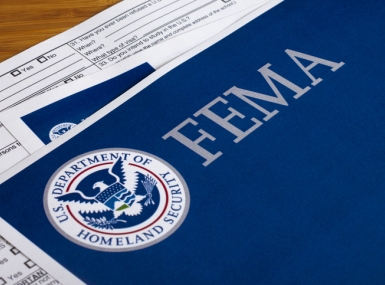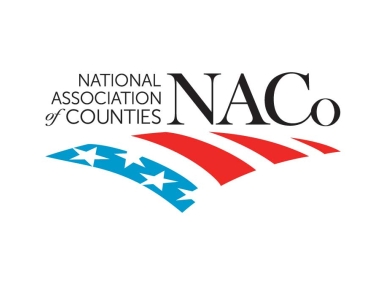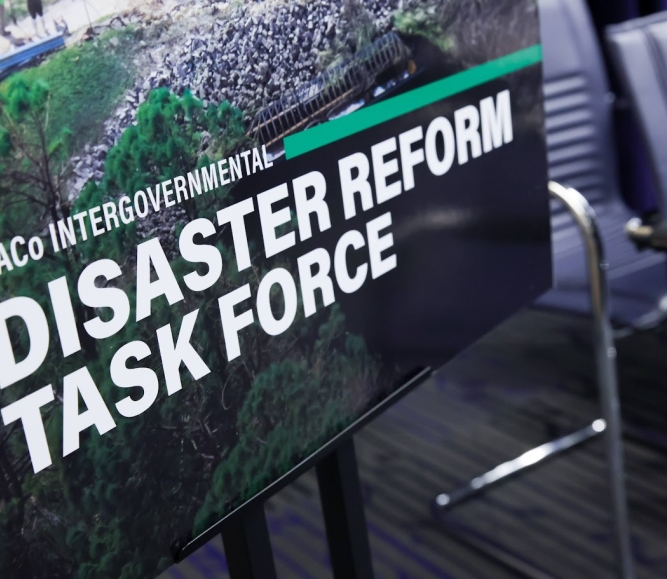FEMA bill staffers offer insights into reform effort
Key Takeaways
Members of the NACo Intergovernmental Disaster Reform Task Force couldn’t have picked a better time to visit Washington, D.C.
Despite the federal shutdown, the Senate is in session, and that’s just the audience counties need to persuade to introduce a companion bill to reform the Federal Emergency Management Agency (FEMA).
Learn more
“Senators are here, they are bored and they are interested in learning something new,” congressional staffer Logan de La Barre-Hays told members of the task force Oct. 28.
de La Barre-Hays (R) and her counterpart Lauren Gros (D) are professional staff members for the House Transportation and Infrastructure Committee, which recently passed the Fixing Emergency Management for Americans Act (FEMA Act) on a bipartisan basis, 57-3. They gave NACo task force members a look at the thinking behind some of the bill’s provisions that would appeal to counties.
The FEMA Act proposes making FEMA, currently part of the Department of Homeland Security, an independent agency. It would also transition to a grant program for public assistance, ending a lengthy reimbursement process that left counties fronting millions of dollars for all sorts of recovery costs. It would also reform mitigation programs, create a universal application to simplify paperwork and transform individual assistance policies.
It would reset a system that has formed over the years
There's nothing in the Stafford Act that prescribes the system as it exists,” de La Barre-Hays said. “It is mostly precedent.”
At the same time, President Trump’s FEMA Review Council is preparing its own recommendations for the agency, which would have to be passed by Congress. The 12-person review council includes a county sheriff — Miami Dade County, Fla.’s Rosie Cordeo-Stutz — and the mayor of Tampa, Fla. The review council is due to provide a report with its recommendations in the second week of December, Jared Borg, deputy director for state governments at the White House Office of Intergovernmental Affairs told the task force.
The White House review council spurred the Transportation and Infrastructure Committee to act with its bill.
“Some of the executive orders coming out of the White House early in the year caused us to think on a bigger level, rather than maybe just trying to tackle the individual assistance components or just trying to make a reform to public assistance,” de La Barre-Hays said.
Both staffers said they hope the Senate moves quickly on a FEMA Act companion bill and for the House to vote on its bill.
“We think it’ll be really helpful to have a bicameral product so that we can demonstrate that this isn’t just a Transportation and Infrastructure position in the House, this is truly Congress’s position on the things that need to be done at FEMA,” Gros said. “We would love to get something moving before the FEMA Review Council’s positions drop, because after that, it becomes a little bit more complicated. Getting ahead and then trying to figure out where we have common ground is probably the best move.”
de La Barre-Hays said that in addition to having its own Office of Inspector General, making FEMA independent would create a new perspective for the agency.
“We can get out of this cultural paralysis, where FEMA is so terrified of making a mistake that, they end up revictimizing communities that are already experiencing the worst days of their lives,” she said,
Gros said the bill’s changes to the BRIC program (Building Resilient Infrastructure and Communities) would increase the accessibility of mitigation funding.
“We’ve shifted it from competitive to being more of a formula grant to provide a predictable stream of financing to basically every community in this country,” she said. “And to encourage states and locals to prepare pre-approved project lists so that when a disaster happens, we have a better sense of how we can spend the money in a high-impact way.”
Most significant for counties, the bill’s transition to a grant process based on cost estimates would remove a significant financial burden.
“It will allow states and locals to better pace recovery and their responsibility for the cost share. and help move things along more efficiently and get us out of this situation where we have more than a thousand open disasters going back to Katrina,” de La Barre-Hays said.
“We believe it will really put you in the driver’s seat, and while we can’t promise that we will completely eliminate the need for any loans or bonds… we provided certainty in the bill that you will get reimbursement for the interest on those items, and we believe that your reliance on them will go down because FEMA has a shot clock on them to get you the money when you need it based on those estimates.”
Borg noted earlier that his office only learned how much money counties were advancing for debris removal after he received information from the North Carolina Association of County Commissioners, which shared insights from Western North Carolina counties’ experiences with Hurricane Helene.
“We didn’t know this was going on, we didn’t realize all the turnover, and this is why it’s so important to have the relationship with our office,” he said. “Last week we talked with OMB (the Office of Management and Budget), and OMB was a little disgusted with what was going on.
“Our goal is to streamline issues like that.”
Task Force members also viewed an hourlong film produced by NCACC that followed several Western North Carolina counties and their leaders over nine months as they recovered from Hurricane Helene, illustrating the challenges they faced not just in physical recovery, but in repairing the health of the communities affected and the emotions of the residents. That film will be available widely after several screenings.
“What really hit home for me…you could substitute any of those elected officials for any elected officials who also were in the midst of a disaster, and the words would make absolutely the same sense,” said Cynthia Lee-Sheng, Jefferson Parish, La. president and co-chair of NACo’s task force. “Immediate needs of housing, immediate needs for funding with debris cleanup, the difficulty in mitigation, the will to make it better and stronger for the future.”
Related News

States file lawsuit challenging FEMA’s new rules on emergency management grants
On November 4, a coalition of 12 states filed a lawsuit against the U.S. Department of Homeland Security (DHS) and the Federal Emergency Management Agency (FEMA), alleging that recent changes to key emergency management grants are unlawful and could disrupt state and local preparedness efforts.

County Countdown – Nov. 4, 2025
Every other week, NACo's County Countdown reviews top federal policy advocacy items with an eye towards counties and the intergovernmental partnership.

County Leaders Advocate for FEMA Act in Visit to Washington, D.C.
Nearly two dozen county leaders from 15 states are in attendance this week at a National Association of Counties (NACo) fly-in focused on disaster reform.
County News
NACo disaster task force extends work into fall
NACo's Intergovernmental Disaster Reform Task Force will continue its work into the fall, following key developments including the release of the FEMA Act discussion draft and heightened engagement with the FEMA Review Council.

